| Send
items to chuck.leinweber@gmail.com
for inclusion here next month.
The Treasure Chest
The Treasure Chest is a place in Reports to put those
cool sailing, cruising, motoring, boatbuilding or boating tips
you have. Send us your ideas... We just need a photo and a short
description.
This time we have...
How to Make a Name Plate
Step 1 Choose a name
Step 2 Choose another name (or have another one
chosen for you).
Step 3 Go through the list of 300 names you have
chosen and argue about it for a while and then settle on a final
name.
Step 4 Pick out your name plate (Here I have a piece
of pine which I will trim down in size later)
Step 5 Print out the name you have chosen in a size
befitting the name plate, in a font befitting the name. For the
Ollie Punt I used Gabrielle.
Unfortunately, if you let yourself go on the internet
looking at places like www.dafont.com,
picking a font is almost as difficult as picking a name.

Step 6 Cut the name out of the paper and glue it
to the name plate using a cheap/water soluble glue like a glue
stick.
Step 7 Take a rotary tool or a set of carving tools and cut out
your choice of either the black bits or the white bits. Being
lazy, I carved away the black bits.

Step 8 Wash, sand or scrape off excess paper.
Step 9 Tidy up, trim, decorate and paint. I used
a bit of pencil to darken in the carving and a bit of varnish.
Step 10 Attach to boat.
Step 11 Put boat in water.
Step 12 Put person in boat.

Yes, it is a white Ollie Punt.
Ian Titulaer
Using Masking Tape When Fibreglassing
Warren Messer has a great tip for fibreglassing. He lays down
a line of masking tape to give a clean edge to the glass when
finished. You put the masking tape down so the fibreglass overlaps
the masking tape. Fibreglass normally but, while the glass is
still green, run a knife along the edge of the glass at the masking
tape line. Remove masking tape and excess glass. You are left
with a rough edge which can be easily removed. Here is his video
on how to do it:
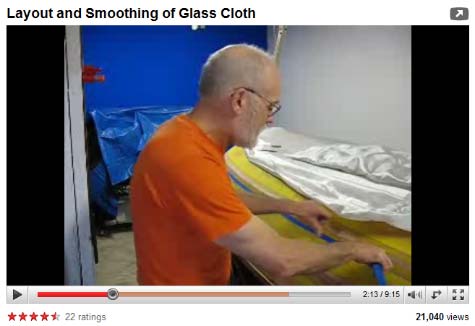
Warren's plans are available at Duckworks here.
The rest of Warren's videos are here.
Tender Behinds in England
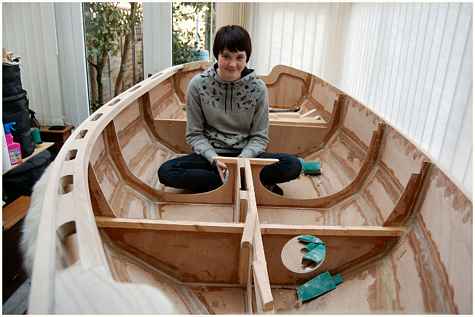
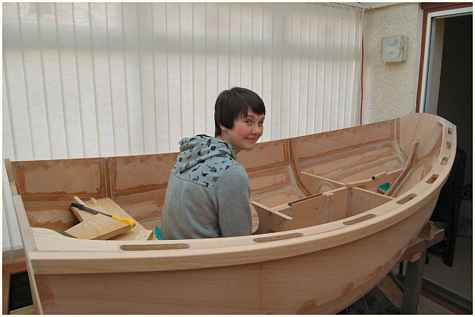
Retired airline Pilot and small boat enthusiast
Mike Austen is busy building two stretched to 8ft long Tender
Behind sailing dinks , one for himself, and one for Daughter Sherry.
His one will eventually become the tender for a bigger boat planned,
but in the meantime, to avoid the snow and sleet that covers his
backyard near Bristol UK he has brought TB number one into the
conservatory at the back of his house, and is contentedly getting
on with the build of number one.
He sent me two pics of the boat as at today, Sherry wanted to
see how it felt in the boat so has climbed in. While the wide
angle lens on the camera does odd things to the proportions Mike
is already getting compliments about the looks and the amazing
amount of space in such a small boat. As we sell a lot of Tender
Behind plans I figured that it was worth showing the little boat
off and mentioning that for those interested in the design He’s
documented the build on his website at https://www.backyardboatbuilding.org.uk/
.
John Welsford
Regatta at Lake Arthur
"Events for Puddle Duck Racers will be included in this year’s
Regatta at Lake Arthur, to be held on August
7-8. The lake can be found in Moraine State Park some 25 miles
North of Pittsburgh. The traditional "Anything That Floats" event
will be modified this year in that entries will be based on Puddle
Duck Racer Hulls and there will be prizes for beautiful, artistic
or outrageous additions to the basic hull. There will also be
a race with a "Le Mans Style" Start. For further information or
notification of intent to participate, please contact the Butler
County Tourism & Convention Bureau. joey@visitbutlercounty.com
You are invited to enter these events, watch the Saturday evening
fireworks, generally join in the fun and enjoy all that this Pennsylvania
Park has to offer. Several nearby campgrounds are available."
The plans for the PDRs below are available at Duckworks. Jim
Michalak has just finished his PDR Catbox
plans with a lateen rig.
Long Tail
Picture taken on a motorcyclist's trip thru southern
India.
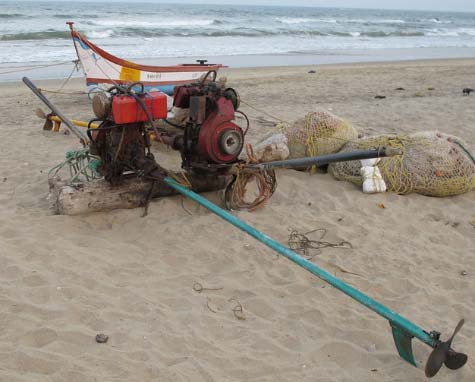
Bruce Armstrong
Finally done the Drake
I have completed making David Beede's OS John boat from the
Simplicity Boat's page. This boat I call the Drake and it has
given me a tough time. Now that it's done, I like it a lot.
https://www.flickr.com/photos/47291288@N07/

Lessons learned;
1.) Don't buy the cheap 3 layer luan plywood even though it is
marked as "Moisture resistant" - it is not. I refer
to the very lightweight luan for $10.99 a sheet with 2 thin layers
of veneer sandwiching some type of soft spongy material that seems
like balsa or pulp. Spring for the $19 per sheet premium underlayment
warranted for 25 years.
2.) Don't try to build a ply-on-frame jon boat from stitch-n-glue
plans. The compound angles where the front transom and sides and
bottom come together are impossible to calculate. This type of
shape should be kept stitch-n-glue.
3.) Do apply a basic camo paint job, makes you want to awaken
your inner sportsman
4.) Do buy some new fishing gear and a cooler.
Thanks
Kenny in Philly
Proa
Hi Chuck!
I'm back! I am sending you some photos from the transportation
from my garden. Thanks to good neighbors, it worked perfectly.
I hope the pictures are good.
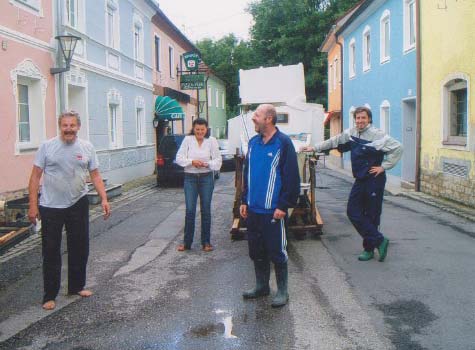
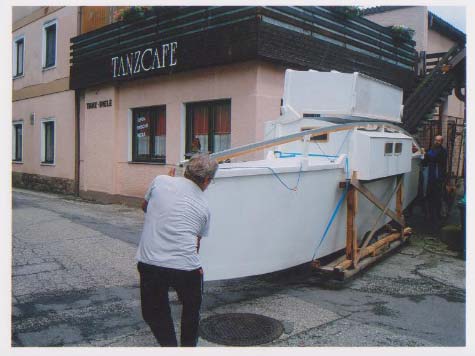

Greetings Willi
Boat building...

Lucas Boatworks and Happy Hour Club
I apologize for this flurry of emails lately. A
lot of things are going on here at the shop that interest me so
I assume you'll be interested also. First is the 20 ft kayak that
Sam just finished. This is one slick boat. There's no substitute
for hull length, that's what Sam said when I told him how easily
this boat slipped through the water. It's also very stable, you
can step into it without tipping over. Things slowed down after
the bear got in but it still went very well. Abigail is a big
yellow Lab who's on a green bean diet to get her slim figure back
by Cedar Key. This boat will be at Cedar Key on May 1 along with
all of you. Next is Helen Marie hanging up ready for the inside
glass job.
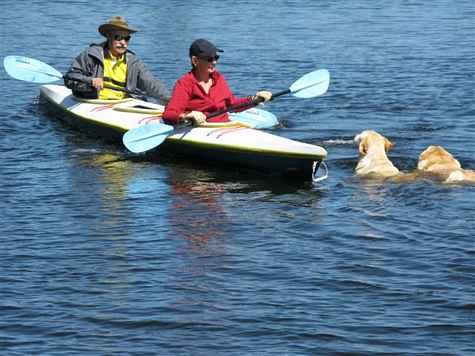
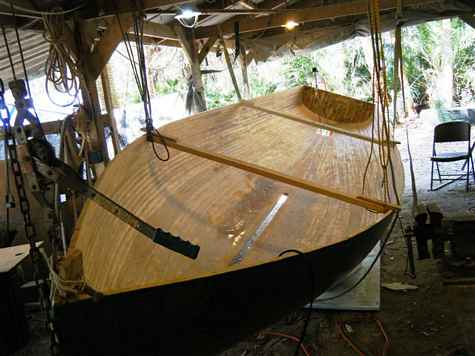

Dave
David Lucas
Lucas Boatworks and Happy Hour Club
(941) 704-6736
Lissa
Since December, we have been working on Lissa/Otter.
The picture below is the most recent. As you may recall, I decided
to used the dimensions and scantlings from Lissa
but the more current all plywood construction as in Jacques Mertans
Otter.
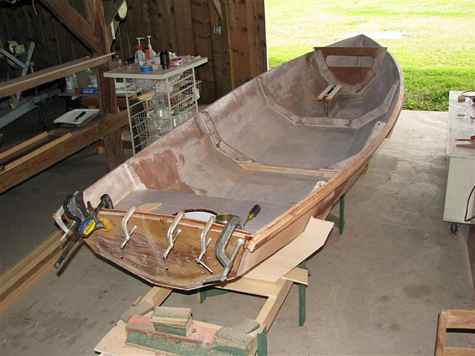
Instead of the timber frames that Lissa
shows, you can see that I used plywood. I used the 6 oz diagonal
bias tape on the seams and 12 oz diagonal bias fabric on the hull
inside. This schedule is very similar to the Vagabond. I am using
the System 3 resin and also QuikFair, both nice products. We are
building the boat in an unheated barn and the cold temperatures
slowed up the building process. I hope to finish before the temperatures
get excessively hot.

With suggestions from Jacques Mertans, I decided
to construct the boat in a basket mold. I first used the mold
technique to build Pepita
and then again for Just Right. This time, I made use
of a laser level to set up the frames. Now that I am nearing the
halfway point, errors usually build up. I am amazed that the frames
and panels are still level and plumb as close as I can detect
with a bubble level and tape. I expect that if I had just cut
and taped I might be farther along. I was able to construct the
mold in a little more than a weekend. It places the boat at a
convenient working level and makes cutting all those extra parts
easier.
Looking at the picture, I have a hard time remembering that Lissa
and Pepita have nearly the same mid
cross-section. Lissa looks a lot bigger.
As you remember, I submitted an entry in the
Duckworks Puget Sound Cruiser contest which
was based on the Lissa. This is a chance
to validate my submission.
I really appreciate the fine quality of Joe Dobler's plans. I
can tell that he thought through lots of the details. Since Joe
built the boat and kept it many years, I think he liked the end
product.
BTW, I see that you added a B&W photo of assembling the Pepita.
Unless I am mistaken, the bald guy is Joe and the young journeyman
is me. I liked the write-up.
Justin Pipkorn
Clint
Chase Boatbuilder
US Agent for François Vivier Architecte
Naval;
Brings CNC Boat Kits to New Boat Builders
Portland,
Maine –Clint Chase is pleased to announce that Clint
Chase Boatbuilder will now be a US agent for precision
cut boat kits for François Vivier, a prolific designer
of ships, yachts, and traditional small craft in
France. Additionally, Clint Chase is contracting
with other designers around the world to bring new
boats and CNC (Computer Numerically Cut) boat kits
to our market for the first time. Vivier’s design
work is iconic in France and other EU countries
and is bound to become equally iconic to the wooden
boatbuilding and boat kit industry in North America.
We
are also providing CNC kits to designs by Michael
Storer, from Adelaide, Australia, Eric Risch, from
Gardner, Maine, and we are in talks with designers
in the UK, Finland, and New Zealand. CNC cutters
in Maine will be employed to cut the kits and ship
them by freight. Cutters in North Carolina and soon
Texas will also be employed in the greater effort
to get kits into the hands of builders around the
country.
Clint
has been cutting kits for several months, but is
impressed by the interest in CNC boat kits by potential
customers, the wooden boat community, and designers
whom he has contacted. About a recent kit delivery,
a customer in Houston, Texas said, “[the Goat Island
Skiff] is a very nice kit overall. I looked at the
wood grain pattern of the tank tops and transom,
a very nice selection! The crate shows that you
care about the things you build. Everything was
well packed and labeled.”
"I
applaud Clint's approach to bring international
boat designers' kits to the North American market.
There are so many creative ideas for small boats
around the globe and Clint is approaching this in
just the right way. We all wish him well. At the WoodenBoat Show[www.thewoodenboatshow.com]
this year (June 25-27, at Mystic Seaport, CT), we
are taking a new approach to Family BoatBuilding [www.familyboatbuilding.com]. For the first
time, we will be inviting independent kit-producing
companies to exhibit and to teach families and groups
how to build their own boats. Clint was one of the
first to contact us, and we are delighted that he
will be building the Echo Bay Dory Skiff with a
number of families. Clint is the consummate teacher,
and we are excited to have him helping us."
---Carl Cramer, publisher of Wooden Boat Magazine
and Professional Boatbuilder
Clint
Chase is a graduate of The Landing School of Boatbuilding
and Design in Kennebunkport, Maine. He started Clint
Chase Boatbuilder after four years running youth
boatbuilding programs. The three pillars of the
business are: ultra-light, wooden masts and spars
(“Birdsmouth” spars for sailboats), custom wood
and composite oars, and precision-cut, CNC Boat
Kits. In the US, there is a growing popularity and
demand for CNC plywood kits for exceptional motor,
sail, and rowboat designs from 8-28 feet. However,
there are only a few kit providers in the market
from which customers can choose and none that are
reaching out to designers abroad to bring their
beautiful boats to the US market. For more information
please visit clintchaseboatbuilder.com and come see our exhibit (building
#2, display 19) at the 2010Maine Boatbuilders
Show [www.portlandcompany.com/boatShow/]
(March 19-21st at The Portland Company Complex in
Portland, Maine).
|

Birdsmouth
Masts & Spars |

Custom
Wood and Composite Oars |

CNC
Boat Kits for row, sail, and power boat |
DuraSafe Coupler Connect
Product of the Week: DuraSafe Coupler Connect™
Friday March 5, 2010
DuraSafe Coupler Connect™ is an easy-to-use trailer alignment
device that also offers optional protection against accidental
trailer uncoupling.
Coupler Connect™ eliminates the problems many people have
with trying to hook up a trailer by locating the trailer coupling
directly over the ball without the need of assistance –
and prevents damage to the tow vehicle. A unique mounting bracket
(fits standard 1” diameter ball shanks) accommodates a wide
range of couplers and ball mounts and allows for maximum turning
radius. MSRP $39.99.
DuraSafe Coupler Connect™ plus Protect offers the same
advantages as the Coupler Connect but also includes a separate,
universal-fit hold down device that prevents the coupler from
accidentally popping off the tow ball during travel. 1.) Use the
guide plate accessory to align the coupler directly over the tow
ball for easy hookup. 2.) Remove the guide plate and insert the
protective hold down accessory to help prevent the coupler from
accidentally popping off the tow ball during travel. The guide
plate can also be used to secure the trailer to the tow vehicle
when a padlock is used. MSRP $54.99.
More info: www.durasafelocks.com
or call 1+262.544.5615.
DuraSafe – 1785 S. Johnson Road – New Berlin, WI 53146
USA
New Fiberglass Boat Repair Book
Fiberglass Boat Repairs Illustrated
comprehensive guide
to major & minor repairs, finishing & painting

JAMESTOWN, RHODE ISLAND (USA) – Fiberglass
Boat Repairs Illustrated, available at chandleries,
bookstores and online this month, is a comprehensive guide to
making repairs to a fiberglass boat and how to finish and paint
those repairs.
Written by Roger Marshall, winner of numerous awards for marine
technical and magazine writing and author of 14 nautical books,
the nine chapters of Fiberglass Boat Repairs Illustrated cover:
how a fiberglass boat is built, identifying hull damage; materials,
tools and basic techniques; gelcoat restoration; making minor
repairs; making major repairs; hull, keel and rudder fairing;
identifying and making osmosis repairs; and finishing and painting
a repair job. There is also an appendix on building a temporary
Shrink Wrap™ shed in which to do boat repair work year-round.
With more than 200 pictures and drawings, the book shows repair
projects as done by the author and other professional and amateur
boat builders, from simply polishing the gelcoat or repairing
a ding in the paint work, to much larger projects such as making
a transom well guard to keep water from flooding over the transom.
The most ambitious project is a complete hull and keel reconstruction
on a boat that went aground and was seriously damaged.
Fiberglass
Boat Repairs Illustrated (ISBN 978-0-07-154992-9,
MHID 0-07-154992-7, ebook ISBN 978-0-07-154993-5) is published
by International Marine/McGraw-Hill. Paperback, 192 pages. US
$24.95.
******

|

